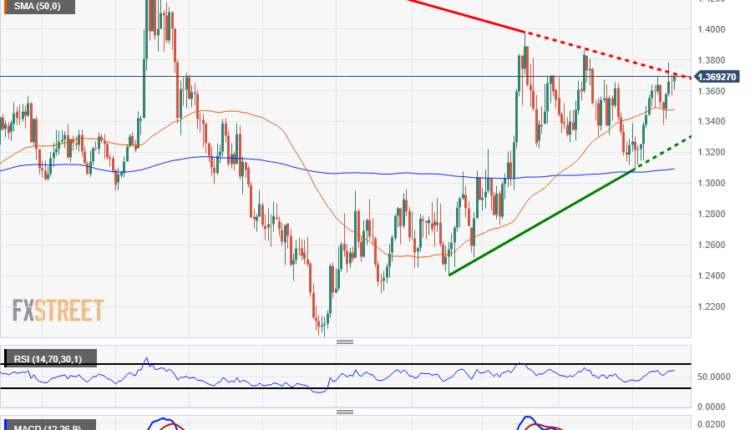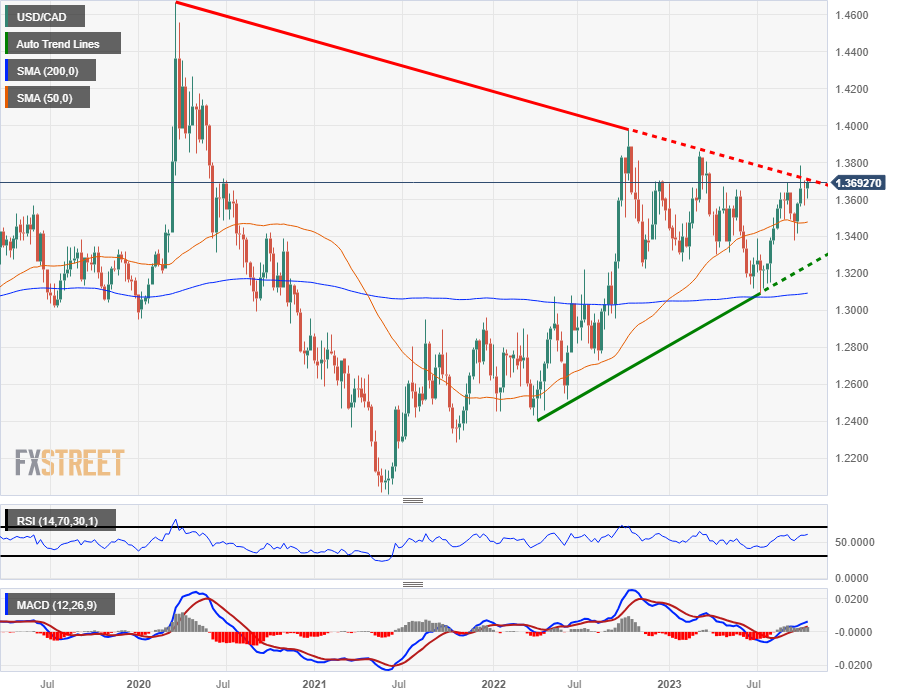Canadian Dollar edges lower on Wednesday as markets turn risk-off, US Treasury yields climb
- The Canadian Dollar is falling back into familiar lows on Wednesday as investors pull up stakes.
- Canada Housing Starts came in better than expected, but risk-off flows are dominating.
- Thin calendar docket for the CAD until Friday’s Retail Sales.
The Canadian Dollar (CAD) is falling back in the American market session as risk appetite takes a turn south, sending investors back into the US Dollar (USD) and taking the USD/CAD back up the charts.
Canada Housing Starts managed to eke out a better-than-expected print, with US housing data coming in mixed, but overall market sentiment has turned risk-off mid-week, and the US Dollar is rising across the board, sending the Loonie lower in lockstep with Crude Oil prices that are declining back into the day’s opening bids.
Daily Digest Market Movers: Canadian Dollar reverses course at the midway point as risk appetite turns tail
- Canadian Housing Starts beat expectations, showing 270.5 thousand additional homes begin constructed over the year into September.
- The data easily cleared the forecast 240K, and stepped over the last reading of 250.4K (revised downwards from 253K).
- US housing data landed with mixed results, with Building Permits beating expectations but Housing Starts flubbing the forecast.
- The US issued 1.475M new building permits in September, just above the 1.45M forecast but less than August’s 1.541M (revised down from 1.543M).
- US Housing Starts disappointed markets, with 1.358M houses or apartment units beginning construction in September, less than the expected 1.38M, but still an improvement over August’s 1.269M (revised down from 1.283M).
- Thursday still sees US Initial Jobless Claims, as well as a slew of speeches from Federal Reserve (Fed) officials, including Fed Chair Jerome Powell at 16:00 GMT tomorrow.
- Crude Oil saw bidding during the early Wednesday trading session, but the American market window is seeing investors hesitate, and Oil prices are falling back to where they started.
- Global geopolitical tensions over the Israel-Hamas conflict continue to weigh on investor risk appetite.
- The US is also suffering from its own homegrown political uncertainty as the US Government struggles to replace its House Speaker who was ejected by his own party.
- US Treasury yields have hit yet another high, with the US 10-year yield at its highest yield in seventeen years near 4.92%.
Technical Analysis: Canadian Dollar falls back as traders pile back into the Greenback
USD/CAD tried to break past the 1.3700 handle on Wednesday before slipping back into 1.3680, testing into swing high prices that have become familiar territory in recent weeks. The pair has been in a massive range for a whole year, oscillating between highs just short of 1.4000 and lows in the 1.31s. It is once again approaching the range highs.
In fact the pair is wrestling with a major trendline at around 1.3685, drawn by connecting the October 2022 and March 2023 highs, and this is likely to present tough overhead resistance. Ideally a decisive break is required to definitively put this ceiling in the rear-view mirror.
Such a break would be characterized by a longer-than-average green weekly candle breaking cleanly through the resistance line, or three successive green weekly bars.
Despite the sideways primary trend, the intermediate and short-term trends are more bullish suggesting longs have their backs to the wind. This lends a bias to more upside, and if it were not for the major resistance line there would be a green light signaling ‘go’ – as it is it could prove a spoiler.
USD/CAD Weekly Chart
Risk sentiment FAQs
In the world of financial jargon the two widely used terms “risk-on” and “risk off” refer to the level of risk that investors are willing to stomach during the period referenced. In a “risk-on” market, investors are optimistic about the future and more willing to buy risky assets. In a “risk-off” market investors start to ‘play it safe’ because they are worried about the future, and therefore buy less risky assets that are more certain of bringing a return, even if it is relatively modest.
Typically, during periods of “risk-on”, stock markets will rise, most commodities – except Gold – will also gain in value, since they benefit from a positive growth outlook. The currencies of nations that are heavy commodity exporters strengthen because of increased demand, and Cryptocurrencies rise. In a “risk-off” market, Bonds go up – especially major government Bonds – Gold shines, and safe-haven currencies such as the Japanese Yen, Swiss Franc and US Dollar all benefit.
The Australian Dollar (AUD), the Canadian Dollar (CAD), the New Zealand Dollar (NZD) and minor FX like the Ruble (RUB) and the South African Rand (ZAR), all tend to rise in markets that are “risk-on”. This is because the economies of these currencies are heavily reliant on commodity exports for growth, and commodities tend to rise in price during risk-on periods. This is because investors foresee greater demand for raw materials in the future due to heightened economic activity.
The major currencies that tend to rise during periods of “risk-off” are the US Dollar (USD), the Japanese Yen (JPY) and the Swiss Franc (CHF). The US Dollar, because it is the world’s reserve currency, and because in times of crisis investors buy US government debt, which is seen as safe because the largest economy in the world is unlikely to default. The Yen, from increased demand for Japanese government bonds, because a high proportion are held by domestic investors who are unlikely to dump them – even in a crisis. The Swiss Franc, because strict Swiss banking laws offer investors enhanced capital protection.



Comments are closed.